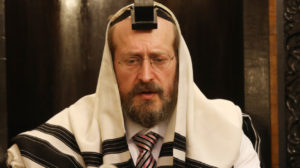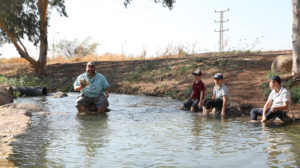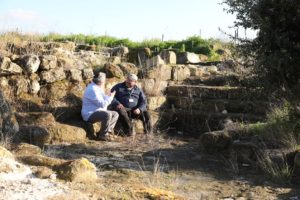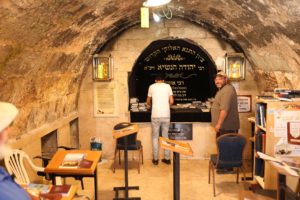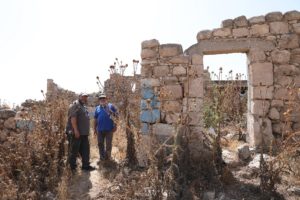High Stakes in Vegas
| July 24, 2019Can you hold tight to your principles at the Vegas trade fairs?
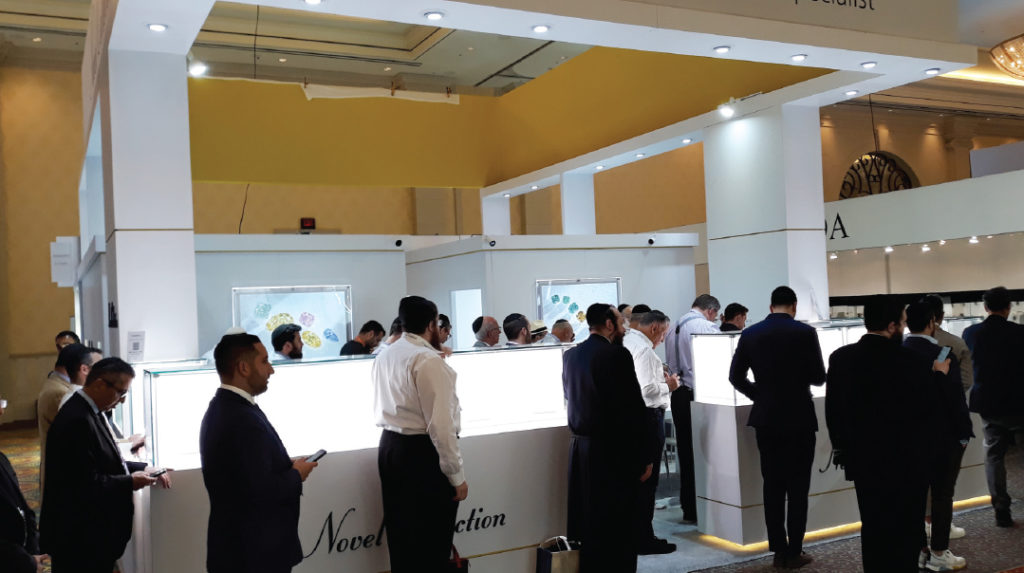
Spending Shabbos on The Strip in Las Vegas wasn’t exactly on my agenda when I made arrangements to be in Los Angeles during the week for a family-related medical issue.
But Anshi, a close relative, would be attending the annual JCK convention there — the leading jewelry event in North America, open to all jewelry professionals and something no one in the diamond industry wants to miss. There’s quite a “matzav” there on Shabbos as well (Shabbat dinner and lunch are elegantly penned into the printed schedule), and while many dealers travel with their spouses, my relative was there by himself. Maybe, he asked, I could spend Shabbos with him? He’d order me hotel accommodations and Shabbos meal tickets — and guaranteed it would be an experience.
I took the last flight out of L.A. on Thursday night, but a several-hour delay meant I arrived in Vegas in the wee hours of the night. You’d never know, though. The noise, the traffic — it could have been the middle of the day. And then, like in an early chassidic tale, I hear the honking as a rental car pulls up alongside the curb. “Shalom aleichem, kumt arein!”
It’s Anshi, with his long peyos and buttoned vest over wool tzitzis — a comforting, if not incongruous sight in these parts. I feel the cool air-conditioning and smell the leather seats, as the notes of Shulem Lemmer’s “Tniyeleh” play softly in the background. The words seem to have been written especially for this night:
“Oifen Veg Aheim… S’kumt a shvere tzeit / Fun Bashefer azoi veit / S’kumt a shvere tzeit / Nisyonos fun yeder ziet / Beim amud einer alien/ Zei ich mein rebbe shtein — On the way home / A hard time comes / And you feel so far from the Creator / A hard time comes / Challenges from every side / A single person stands at the amud / I see my rebbe standing...”
Las Vegas is the convention capital of the world, and industries common in the frum world draw hundreds of Orthodox visitors. Nothing compares to the diamond convention when it comes to Jewish representation, although the consumer goods (close-out) shows, the real-estate convention and the jewelry and electronics fairs all draw large delegations from the Torah community.
One of the main representatives at this week’s JCK convention is the Israeli Diamond Institutes. Dozens of Israeli diamond companies prepare for months for this exhibit and have very high expectations from it. The US is the largest market for polished diamonds from Israel, comprising nearly half of the Israeli exports.
The connection between Jews and diamonds is no secret, and the large number of Jews in this industry means that there are concepts in Hebrew and Yiddish that have become part of the diamond dealers’ jargon. The most famous example is the expression “mazel u’brachah” that diamond dealers — Jews and non-Jews alike — seal every deal with. Some just truncate it to “mazel.”
“Do you want to see the city?” Anshi asks as we stop at a traffic light. “The best time is during fahr-tugs (at daybreak). Tomorrow when we go to the mikveh, everyone is sleeping. The air is clean and we have a daf yomi shiur at the hotel.”
The difference between night and daybreak reveals the essence of what Las Vegas, the gambling and entertaining center of the world, is really all about. At night the city is all glitz and glitter, but in the morning, you see how the region is all really a huge barren desert. All the glory and grandeur, the largest and most opulent hotels in the world, are only a cover for one of the most arid places on earth.
Who chose to build so many grand castles in this place? It began with a Mexican merchant named Antonio Armijo. In 1829, he led a convoy of 60 people to Los Angeles, which was then a small town on the coast of the Pacific Ocean. They were traveling along what was known as the “Spanish Route,” when Armijo ordered his people to stop. They desperately needed water, and Armijo sent a few scouts to find a water source.
One of the scouts, Raphael Riviera, entered the desert 160 kilometers from where the convoy was camped, and discovered an oasis. The route to Los Angeles was remapped, and the oasis became a milestone on the journey out west. Vegas, they called the place in Spanish, which means a pasture or a meadow. For 14 years, the location was a rest stop on the route of the gold prospectors heading west.
Then John Charles Fremont, a politician, soldier, and American researcher who led expeditions to Oregon and California, reached Las Vegas and literally put the place on the map. Years later, Las Vegas repaid him by naming a street in the heart of the hotel district after him. When Brigham Young, leader of the Mormon sect, led his people to settle around the Great Salt Lake in 1844, Las Vegas became an important stop to protect the mail route between L.A. and what became Salt Lake City.
The small Nevada desert town began to thrive with the construction of the Hoover Dam in the 1930s, and by 1960, it had a population of 64,000. Today, the neon lights and the glitzy hotels that dominate the city are the perfect setting for America’s desert fantasyland.
The JCK convention is being held at the Venetian Resort Hotel Casino, a resort complex which, together with the adjacent Sands Expo Convention Center, is the world’s second largest hotel, with over 4,000 rooms and 3,000 suites.
“Do you get it?” Anshi asked. “It’s the big bluff of This World. Everything looks so glittery and shiny here, but after you travel a few miles either left or right, you see poor, struggling communities.”
But bluff or not, it’s the convention capital of the world, and for an international diamond conference, the organizers know they’ll do well if they cater to the outsized Jewish — and predominantly Orthodox — crowd. In fact, next year’s show dates have already been adjusted to accommodate the Shavuos holiday.
The men at the daf yomi shiur and the Shacharis that followed are going to be dealing in huge sums today. But that doesn’t mean that the davening here isn’t calm and measured. “The Shulchan Aruch says that one needs to daven ‘as though he is counting money.’ Here you have people who know how to count money,” quips Zalman Weinberger, a cheerful Satmar chassid from Williamsburg.
And he’s not kidding. Zalman’s company joins 2,300 diamond companies from around the world exhibiting. You need a map to navigate through it all, as well as a special tag with a bar code. And with billions of dollars under one roof, security is super-tight.
It’s the first time I’ve seen the art of diamond negotiations up close: A dealer from Singapore passes by a booth manned by chassidim from Antwerp. He glances at a large, heart-shaped stone displayed in a reinforced display case, stares at it for a few seconds and emits a low whistle, indicating how impressed he is.
He asks to examine it. The next part reminds me of a daled minim market in Bnei Brak, as he takes out a loupe, closes one eye and studies the piece closely.
Singapore: “How much does it cost?”
Antwerp: “How much do you think it should cost?”
Singapore: “Look, I have a few estimates. But let me phrase it differently: How much below the Rap is it?” (“Rap,” as every beginner dealer knows, is the famous price list that was compiled by a religious Jew named Martin Rapaport.)
Antwerp: “Well, for under the Rap I already have another buyer. If you want it, it has to be higher.”
A few more minutes of vigorous haggling, until someone will name a price. That’s how negotiations work.
“We come to feed our families,” Shloime Hartman, who comes from Canada, tells me later in the kosher hall, “but there’s a quiet shlichus here. We know the stereotype about religious Jews and we’re here to debunk it, to show honesty, dignity, and respect. It’s very satisfying when we can show them our best face.”
Shabbos brings its own halachic concerns. Some are makpid to get a room on a low floor, but low is relative, because the lowest available rooms here are on the sixth and seventh floors. A more pressing issue is the key. How can you open a door controlled by a magnetic key card? It’s a problem in many hotels, but here, it’s twofold, because the entry to the area where the guest rooms are located also requires authentication by a magnetic card. Fortunately, the production company in charge of the exhibit is on hand and makes every effort to help the Jewish guests. They don’t want to forfeit the participation of hundreds of important companies.
They also bring the local Chabad shaliach into the picture. There are several shluchim here in a number of Chabad Houses and they work hard — servicing convention-goers is a full-time job. The head shaliach, Rabbi Mendy Harlig, works together with his brother, Reb Yehoshua, to help Jews remain connected in what’s known as Sin City.
One of their areas of expertise is the complex issue of eiruvei chatzeiros. “When you’re talking about such a huge complex of rooms, then without an eiruv chatzeiros you can’t carry anything in the entire complex,” explains Jeff, an Orthodox diamond dealer from Long Island.
In order to make eiruvei chatzeiros, a kinyan has to be made. That being the case, the Chabad shaliach needs to set up a meeting with one of the owners. How does he go about explaining a kinyan? It’s complicated, but it boils down to raising a piece of cloth.
The owners of the Venetian are naturally wary about this whole thing. Is there a catch? “What does it actually mean?” they ask the Chabad rabbi, and receive a long and detailed response about an eiruv and making the rooms and corridors a common space, so to speak. “But you’re not going to take any beds out to the corridors, right?” they ask, worried.
Shabbos comes, and I’m swept along in a virtual convoy of hundreds of Jews, heimishe Yidden who’ve found routes that avoid the bustling centers, because it’s not so pleasant to be wearing a shtreimel and white socks while walking through a casino.
Jews from all over the world, at various levels of observance, enter a magnificent hall and greet each other with warm handshakes. There are siddurim and Chumashim on the table, and someone photocopied a Be’er Haparshah booklet of Rav Meilech Biderman. There’s no Shabbos siren, but still, in our little section, Las Vegas is enveloped in the holiness of Shabbos.
The hall where the meals are being served will open in 20 minutes. In the meantime, the diamond dealers are doing what people do in every shul. They exchange pearls of wisdom about the parshah. It’s the great unifier of the Jewish People. You’re standing with dozens of Yidden, most of whom hardly know one another, but everyone knows the parshah.
The dining hall where the Shabbos seudah is being served is one flight up. There is an escalator — some are meikil and use it, relying on a particular halachic ruling. Most are stricter, taking the much longer route through the emergency stairs — a stark reminder that elegance is only surface-deep. These no-go zones that see no foot traffic except for Shabbo Yidden are lined with pipes and other necessary but very unbeautiful infrastructure accessories.
The table of Satmar gvirim isn’t sufficing with the lettuce and sprouts offered by the hotel. They’ve brought all the holy foods — because there is no such thing as Shabbos without kugel and arbes. Shabbos is Shabbos. But they’re not keeping their Shabbos fare to themselves. They walk among the tables and distribute their treats.
And the zemiros — a real kibbutz galuyos, from traditional Bukharian tunes to those from Budapest and from Lodz. Jews sitting and singing together, talking about everything, except business. “Tomorrow,” they announce before we part, “there’s a shiur before davening.”
After Shacharis, someone from London gets up. He gives a short speech about tests, about the only test that one is allowed to give HaKadosh Baruch Hu — the test of tzedakah. He speaks about Chabad’s tremendous work here, and although he’s litvish through and through, calls on everyone to offer their support.
It’s actually an introduction to the sale of the aliyos. The dealers here know their craft well. For the earlier aliyos, there are fewer takers, so you can get more for your money. Hagbah and gelilah are in high demand, because you can honor two people.
“You don’t realize how much mesirus nefesh is invested into this Shabbos,” a young man from Boro Park named Shea reflects. He represents an upscale brand. “We have a lot of non-Jewish agents. We could just turn a blind eye and let them do the work on Shabbos, but no. Absolutely not. Shabbos is absolute work vacation. Even the non-Jews know that anyone who does business on Shabbos is at risk of being fired. Shabbos is the biggest blessing,” he says.
On Shabbos afternoon, the beis medrash is packed. People are catching up on shiurim from the whole week. “What else is there to do?” chuckles a knitted yarmulke wearer. He is from Herzliya, and is a serious tycoon.
After Seudah Shlishis, replete with divrei Torah and chassidic niggunim, followed by Maariv, hundreds of people stand up for Havdalah. They sing Hamavdil, fold their talleisim, and then recite Veyiten Lecha, averring that at the bottom line, the brachah of parnassah is not dependent on actions, but rather on chesed and abundance from Above.
Following the Shabbos experience, I start reaching out to people who do this regularly, and there are many. Some of the largest annual conventions draw many shomrei Torah u’mitzvos — there’s consumer electronics in January, commercial construction in February, health care in March, jewelry in June, and consumer goods in July, among them.
As the moral climate in Las Vegas (which is still holding its own as America’s most sought-after convention location, even as Orlando, Chicago, and Anaheim have taken their share of the convention pie) continues to sink, how do frum convention-goers adjust?
Avi Gelder, a slim yeshivish sort from Lakewood, has been attending these conventions for several years, and he opens with a disclaimer. “The best option when it comes to Vegas is not to come at all. I know there is much talk about how much more convenient it’s become for a frum visitor, the kosher food and davening options, but that’s only half the story,” he emphasizes. “The moral climate here, the distractions, the gambling and unsuitable sights, make it a big bedieved. Stay home if you can. Work online if you can. And if you must come, it’s advisable to stay at one of the small motels out of the city, about 15 minutes away. It’s not that far, and you’ll be exposed to much less.”
That said, there have been certain upgrades that make it a bit easier for one determined to protect his eyes and mind.
“There are many off-site options,” says Shmiel Gelb, a buyer for a large electronics retailer. “I found a Renaissance Hotel that is close to the convention center, but has no casino. At least you can walk down the hall without feeling like you’re being assaulted. Also, Uber-Eats has made it possible to order dinner without having to leave your hotel room to go to a restaurant.
“You know, even many of the large companies no longer let their representatives stay on the Strip, in the large casino-hotels, because they feel like it’s impossible to focus on work that way. Isn’t that mechayev us? Doesn’t that obligate us, a nation that always has to be ‘focused on work?’ ”
When it comes to Shabbos, along with Chabad, who stands ready to host and accommodate any Jew, the local Young Israel has been very welcoming, says Jerry Nachmanski, a veteran construction-industry executive. “I come home from these trips inspired by the readiness of Jews to open their homes to others. It’s hard to be away from my own home, but there’s a very nice lesson to be learned,” he says.
Gedaliah Klein of Flatbush comes home after every trip with trinkets and gifts for his family — and an immense respect for the Sephardic community. “We have chassidim and yeshivah guys at conventions,” he reflects, “but none of us have done what the Syrian community has done with regard to creating organized, respectful places to daven. There are printed schedules that go out listing minyan times — starting from Korbanos! — and spacious, private rooms rented within the hotel for that purpose.”
One year, the consumer-goods convention, which hosts many of those in the close-out and toy industry, fell out over Tishah B’Av. “The Syrians saw to it that we had a real Tishah B’Av, as if we were in Brooklyn or Lakewood.”
He also mentions the Cleveland-based Mazel Company, which has upgraded the tefillah experience at the summertime ASD Marketweek show. “There’s something special about davening there, creating kedushah in those venues,” he says.
I contact the Syrian businessman who makes these minyanim happen. The gentleman, who prefers to go unnamed, tells me it takes weeks of negotiating with the hotel before the actual convention, ensuring that there’s enough space, and going back and forth over the price for the room. And, my Syrian friend emphatically adds, “Chabad gets all the credit. Not some of the credit. They work with us and the hotels at every step of the way to make it possible.”
On a personal level though, people are becoming more aware of the dangers, says a respected Lakewood rav.
“Balabatim ask questions before they go. They know it’s a danger zone for shemiras einayim and they care. One of the Lakewood real estate companies took a large contingent to a trade show in Vegas — and they prepared a full schedule. After work, there was a delicious supper, and the owner paid to bring in leading rabbanim to speak, making it entertaining and uplifting.”
Nevertheless, maintains Avi Gelder, “I still think it should be avoided. But if you’ve got to do it, and you’re determined, I guess it can be done. Jews find eitzos. Even in Las Vegas, we’ve found a way. We’ve created a spiritual oasis in the desert.” —
—With additional reporting by Mishpacha staff
(Originally featured in Mishpacha, Issue 770)
Oops! We could not locate your form.

